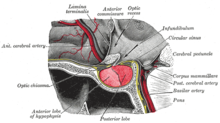
Back قصور النخامية Arabic Хипопитуитаризъм Bulgarian Hipopituarizam BS Hipopituïtarisme Catalan Hypophyseninsuffizienz German Hipopituitarismo Esperanto Hipopituitarismo Spanish کمکاری هیپوفیز Persian Panhypopituitarisme French Hipopituitarisme ID
| Hypopituitarism | |
|---|---|
 | |
| The pituitary gland on a plate from Gray's Anatomy (1918). The anterior lobe is on the left, and the posterior lobe on the right, both in red. | |
| Specialty | Endocrinology |
Hypopituitarism is the decreased (hypo) secretion of one or more of the eight hormones normally produced by the pituitary gland at the base of the brain.[1][2] If there is decreased secretion of one specific pituitary hormone, the condition is known as selective hypopituitarism.[3] If there is decreased secretion of most or all pituitary hormones, the term panhypopituitarism (pan meaning "all") is used.[4]
The signs and symptoms of hypopituitarism vary, depending on which hormones are undersecreted and on the underlying cause of the abnormality. The diagnosis of hypopituitarism is made by blood tests, but often specific scans and other investigations are needed to find the underlying cause, such as tumors of the pituitary, and the ideal treatment. Most hormones controlled by the secretions of the pituitary can be replaced by tablets or injections. Hypopituitarism is a rare disease, but may be significantly underdiagnosed in people with previous traumatic brain injury.[1] The first description of the condition was made in 1914 by the German physician Dr Morris Simmonds.[5]
- ^ a b Cite error: The named reference
Schneiderwas invoked but never defined (see the help page). - ^ "Hypopituitarism" at Dorland's Medical Dictionary
- ^ Ignatavicius, Donna; Workman, Linda (2015). Medical-Surgical Nursing: Patient-Centered Collaborative Care (8 ed.). Saunders. pp. 1266–67. ISBN 9781455772551.
- ^ "Panhypopituitarism" at Dorland's Medical Dictionary
- ^ Cite error: The named reference
Simmonds1914was invoked but never defined (see the help page).
© MMXXIII Rich X Search. We shall prevail. All rights reserved. Rich X Search